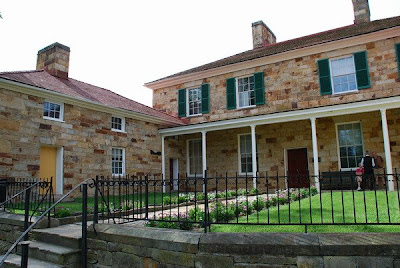 At the end of July each summer, Canton, Ohio plays host to a week-long festival of events surrounding the induction of new professional football players to the Professional Football Hall of Fame (HOF).
At the end of July each summer, Canton, Ohio plays host to a week-long festival of events surrounding the induction of new professional football players to the Professional Football Hall of Fame (HOF).One of our favorites are the balloon launches and fly-overs and the twilight Balloon Glow at Kent State/Stark Tech in Jackson Township (Belden Village area). (see left, click to enlarge)
 The Glow brings an entire infield of
The Glow brings an entire infield ofballoons together and are inflated
but do not lift off. As dusk falls, the
propane flames filling the balloons
casts off a wonderful hue, hence the
"glow" label. Choreographed (well,
sorta) to music, it's a great event
that's attended by hundreds. (see right,
click to enlarge)
 Those who live in northern Stark County were treated to the balloons drifting into Lake Township after dinner time, with many of them landing near the same area.
Those who live in northern Stark County were treated to the balloons drifting into Lake Township after dinner time, with many of them landing near the same area.At one point the sky was pock-marked with dozens of balloons. As they began to drift downward you can only imagine the startled neighbors hearing the sudden burst of propane and the excited chattering of children looking skyward. (see left, click to enlarge)
Even the cows have to wonder what's up with the balloons... (see below, click to enlarge)

 Balloons are quite the stealth vehicle.
Balloons are quite the stealth vehicle.One morning walking from my door
to the mailbox to fetch the paper
at 6 in the morning, I was startled
to a near coronary when a balloonist
blasted a shot of propane into his
balloon while drifting over my house.
In the picture to the left, I like how
the crew is lit by the flame and how
the logo of the Mayflower Balloon
seems to glow aflame itself.
 I also found it oddly comic that as the Glow came to an end and the balloons began to deflate, that the truck-shaped balloon sponsored by United Van Lines appeared to be crashing headfirst into the Mayflower (also a moving company) balloon (see right, click to enlarge). And just where is the Nationwide or Progressive balloon to assess the damage (is there even one)?
I also found it oddly comic that as the Glow came to an end and the balloons began to deflate, that the truck-shaped balloon sponsored by United Van Lines appeared to be crashing headfirst into the Mayflower (also a moving company) balloon (see right, click to enlarge). And just where is the Nationwide or Progressive balloon to assess the damage (is there even one)?The Balloon Classic at the HOF Festival is a favorite and one of many great food and fun aspects to a summer of festivals around Ohio.
-J
























